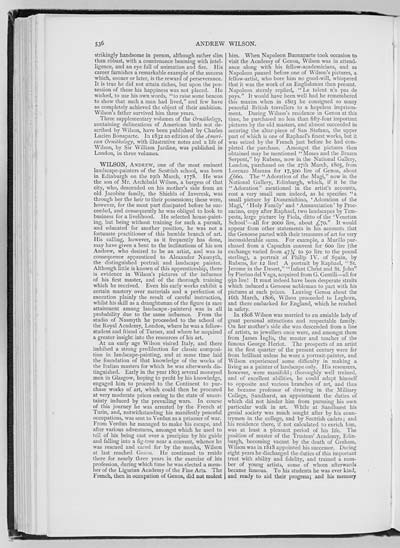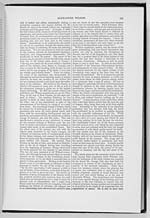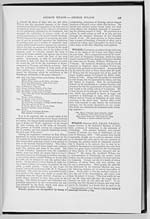Volume 3 > Half-Volume 6
(182) Page 536 - Wilson, Andrew
Download files
Individual page:
Thumbnail gallery: Grid view | List view

536 strikingly handsome in person, although rather slim than r�bust, with a countenance beaming with intel- ligence, and an eye full of animation and fire. His career furnishes a remarkable example of the success which, sooner or later, is the reward of perseverance. It is true he did not attain riches, but upon the pos- session of these his happiness was not placed. He wished, to use his own words, "to raise some beacon to show that such a man had lived," and few have so completely achieved the object of their ambition. Wilson's father survived him three years. Three supplementary volumes of the Ornithology, containing delineations of American birds not de- scribed by Wilson, have been published by Charles Lucien Bonaparte. In 1832 an edition of the Ameri- can Ornithology, with illustrative notes and a life of Wilson, by Sir William Jardine, was published in London, in three volumes. WILSON, ANDREW, one of the most eminent landscape-painters of the Scottish school, was born in Edinburgh on the 19th March, 1778. He was the son of Mr. Archibald Wilson, a burgess of that city, who, descended on his mother's side from an old Jacobite family, the Shields of Inveresk, was through her the heir to their possessions; these were, however, for the most part dissipated before he suc- ceeded, and consequently he was obliged to look to business for a livelihood. He selected house-paint- ing, but being without training for such a pursuit, and educated for another position, he was not a fortunate practitioner of this humble branch of art. His calling, however, as it frequently has done, may have given a bent to the inclinations of his son Andrew, who desired to be an artist, and was in consequence apprenticed to Alexander Nasmyth, the distinguished portrait and landscape painter. Although little is known of this apprenticeship, there is evidence in Wilson's pictures of the influence of his first master, and of the thorough training which he received. Even his early works exhibit a certain mastery over materials and a perfection of execution plainly the result of careful instruction, whilst his skill as a draughtsman of the figure (a rare attainment among landscape-painters) was in all probability due to the same influence. From the studio of Nasmyth he proceeded to the school of the Royal Academy, London, where he was a fellow- student and friend of Turner, and where he acquired a greater insight into the resources of his art. At an early age Wilson visited Italy, and there imbibed a strong predilection for classic composi- tion in landscape-painting, and at same time laid the foundation of that knowledge of the works of the Italian masters for which he was afterwards dis- tinguished. Early in the year 1803 several moneyed men in Glasgow, hoping to profit by his knowledge, engaged him to proceed to the Continent to pur- chase works of art, which could then be procured at very moderate prices owing to the state of uncer- tainty induced by the prevailing wars. In course of this journey he was arrested by the French at Turin, and, notwithstanding his manifestly peaceful occupations, was sent to Verdun as a prisoner of war. From Verdun he managed to make his escape, and after various adventures, amongst which he used to tell of his being cast over a precipice by his guide and falling into a fig-tree near a convent, whence he was rescued and cared for by the monks, Wilson at last reached Genoa. He continued to reside there for nearly three years in the exercise of his profession, during which time he was elected a mem- ber of the Ligurian Academy of the Fine Arts. The French, then in occupation of Genoa, did not molest him. When Napoleon Buonaparte took occasion to visit the Academy of Genoa, Wilson was in attend- ance along with his fellow-academicians, and as Napoleon paused before one of Wilson's pictures, a fellow-artist, who bore him no good-will, whispered that it was the work of an Englishman then present. Napoleon sternly replied, "Le talent n'a pas de pays." It would have been well had he remembered this maxim when in 1803 he consigned so many peaceful British travellers to a hopeless imprison- ment. During Wilson's residence in Genoa at this time, he purchased no less than fifty-four important pictures by the old masters, and almost succeeded in securing the altar-piece of San Stefano, the upper part of which is one of Raphael's finest works, but it was seized by the French just before he had com- pleted the purchase. Amongst the pictures then obtained may be mentioned " Moses and the Brazen Serpent," by Rubens, now in the National Gallery, London, purchased on the 27th March, 1805, from Lorenzo Marana for 17,500 lire of Genoa, about �66o. The "Adoration of the Magi," now in the National Gallery, Edinburgh, which, if it be the "Adoration" mentioned in the artist's accounts, cost a very small sum indeed, as he specifies "a small picture by Domenichino, 'Adoration of the Magi,' ' Holy Family' and ' Annunciation' by Proc- cacino, copy after Raphael, two landscapes by Tem- pesta, large picture by Piola, ditto of the 'Venetian School'�all for 2000 lire, about ,�70." It would appear from other statements in his accounts that the Genoese parted with their treasures of art for very inconsiderable sums. For example, a Murillo pur- chased from a Capuchin convent for 600 lire (the exchange varied from 47� to 50 lire to the pound sterling), a portrait of Philip IV. of Spain, by Rubens, for 12 lire! A portrait by Raphael, "St. Jerome in the Desert," "Infant Christ and St. John" by Pierino del Vaga, acquired from G. Gentili�all for 950 lire! It must indeed have been desperate straits which induced a Genoese nobleman to part with his pictures at such prices. Leaving Genoa about the 16th March, 1806, Wilson proceeded to Leghorn, and there embarked for England, which he reached in safety. In 1808 Wilson was married to an amiable lady of great personal attractions and respectable family. On her mother's side she was descended from a line of artists, as jewellers once were, and amongst them from James Inglis, the master and teacher of the famous George Heriot. The prospects of an artist in the first quarter of the present century were far from brilliant unless he were a portrait-painter, and Wilson experienced some difficulty in making a living as a painter of landscape only. His resources, however, were manifold; thoroughly well trained, and of excellent abilities, he could adapt himself to opposite and various branches of art, and thus he became professor of drawing in the Military College, Sandhurst, an appointment the duties of which did not hinder him from pursuing his own particular walk in art. While at Sandhurst his genial society was much sought after by his coun- trymen in the college, and by Scottish cadets; and his residence there, if not calculated to enrich him, was at least a pleasant period of his life. The position of master of the Trustees' Academy, Edin- burgh, becoming vacant by the death of Graham, Wilson was in 1818 appointed his successor. During eight years he discharged the duties of this important trust with ability and fidelity, and trained a num- ber of young artists, some of whom afterwards became famous. To his students he was ever kind, and ready to aid their progress; and his memory
Set display mode to:
![]() Universal Viewer |
Universal Viewer | ![]() Mirador |
Large image | Transcription
Mirador |
Large image | Transcription
Images and transcriptions on this page, including medium image downloads, may be used under the Creative Commons Attribution 4.0 International Licence unless otherwise stated. ![]()
| Biographical dictionary of eminent Scotsmen > Volume 3 > Half-Volume 6 > (182) Page 536 - Wilson, Andrew |
|---|
| Permanent URL | https://digital.nls.uk/74514638 |
|---|---|
| Attribution and copyright: |
|
| Description | Volume III. Contains names alphabetically from Macadam to Young. |
|---|

